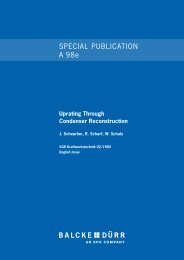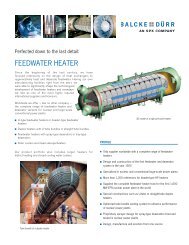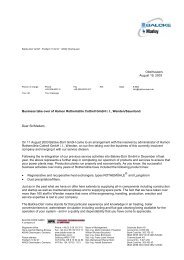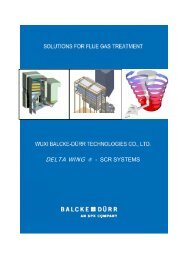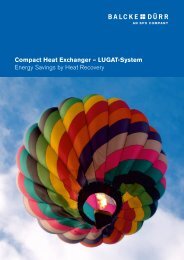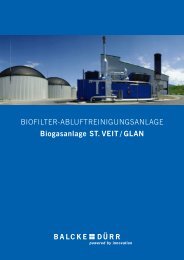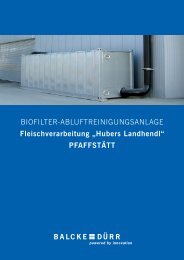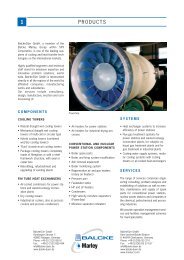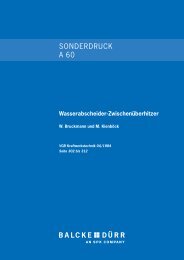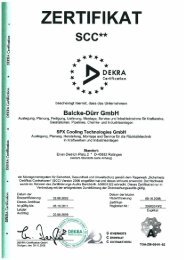Special Publication from Nuclear Europe Worldscan ... - Balcke-Dürr
Special Publication from Nuclear Europe Worldscan ... - Balcke-Dürr
Special Publication from Nuclear Europe Worldscan ... - Balcke-Dürr
You also want an ePaper? Increase the reach of your titles
YUMPU automatically turns print PDFs into web optimized ePapers that Google loves.
<strong>Special</strong> <strong>Publication</strong> <strong>from</strong> <strong>Nuclear</strong> <strong>Europe</strong> <strong>Worldscan</strong><br />
No.9-1 0/1999 / Page 44 to 45<br />
UPRATING BY INSTALLING<br />
HIGH-PERFORMANCE TUBE BUNDLES<br />
IN TURBINE CONDENSERS<br />
Winfried Schulz and Jörg Stahlhut<br />
ENGINEERING<br />
Merger of <strong>Balcke</strong>-<strong>Dürr</strong> Energietechnik and Thermal Engineering International
~ ~. 5]"' JlJl rB)~@<br />
: flj A Ilfl II R~ lf\1~ t:;;J)<br />
In 1998 the operator of the Gef111an 2 X<br />
1350-MW nuclear power plant Gundremmingen<br />
(BWR) was faced with the task of<br />
refurbishing the four turbine surface condensers<br />
ofpower generating units B and C<br />
because ofthe erosion and corrosion damage<br />
to the cooling tubes made ofbrass. The<br />
condensers belonging to the boiling water<br />
systems which have been in operation for<br />
about 14 years are fitted with a total of approximately<br />
4 X 43000 tubes and have a<br />
heat exchange surface area of about 4 X<br />
38300 m2.<br />
Refurbishment concepts<br />
There was a choice between three refurbishment<br />
concepts which were subject of<br />
a preliminary study:<br />
(I) retubing on jobsite using the previous<br />
tube material brass and previous tube field<br />
geometry;<br />
(II) retubing onjobsite using the new tube<br />
material stainless steel and previous tube<br />
field geometry;<br />
(III) installing of tube bundle modules<br />
completely prefabricated at works and<br />
made of the new tube material stainless<br />
steel with improved tube field geometry<br />
according to <strong>Balcke</strong>- <strong>Dürr</strong> TEPEE-design.<br />
<strong>Nuclear</strong> Eurape Warldscan 9-10/1999<br />
The comparison of the results obtained<br />
<strong>from</strong> the study and set out in the table below<br />
shows that concept III involving the<br />
installation of new prefabricated tube bundles<br />
(variants 5 and 6) can be applied in<br />
comparatively short reconstruction time<br />
and also leads to an increase in the output<br />
ofthe turboset, i.e. it is the most economic<br />
and best technical solution.<br />
Both variants which entail retubing on the<br />
jobsite (concepts I and II) require significantly<br />
longer outages for reconstruction.<br />
A further disadvantage of concept I is that<br />
the wet steam erosion resistance of the<br />
cooling tubes is not adequately improved<br />
by continuing to use brass as the tube material.<br />
This improvement is achieved by concept<br />
II through the use of stainless steel tubes<br />
but at the cost of a reduced turboset output.<br />
In view ofthe considerably lowerthermal<br />
conductivity of stainless steel compared<br />
to brass, the retention ofthe existing<br />
tube field geometry means a reduction in<br />
the heat transition coefficient and consequently<br />
a rise in the condenser pressure as<br />
well as a decrease in output. The tube field<br />
geometry must therefore be changed in<br />
order to avoid these undesirabte forfeits in<br />
performance.<br />
Cross-section through a condenser (four TEPEE tube bundles)<br />
; :;- r : "."." ,<br />
i ~<br />
: j .<br />
! ~<br />
v~,<br />
tf<br />
; i<br />
;~<br />
; I l<br />
;<br />
.<br />
j<br />
,. I<br />
; I<br />
ii<br />
, ~<br />
l<br />
t t C<br />
L<br />
I<br />
11<br />
!<br />
.<br />
I<br />
.<br />
c<br />
!<br />
. ;<br />
.<br />
I,<br />
r;<br />
JJEk<br />
j I<br />
TEPEE bundle modules<br />
For the aforementioned reasons the decision<br />
was taken to completely replace the<br />
existing tube bundle with a modem TE-<br />
PEE bundle1 as a modular construction.<br />
This proven bundle design, whose thermohydraulically<br />
optimized form is reminiscent<br />
of an Indian tent (Tepee ), allows<br />
the steam-side pressure drop in the condenser<br />
to be kept to a minimum, the noncondensable<br />
gases to be extracted specif -<br />
ically and the undesirable condensate subcooling<br />
to be virtually avoided.<br />
An increase in the electrical turboset output<br />
of more than 20 MW is achieved at<br />
rated load point using the thin-walled (0.5<br />
and 0.7 mm) cooling tubes made of stainless<br />
steel (DIN Mat. No. 1.4439). For this<br />
particular application, the high efficiency<br />
and capacity of the TEPEE bundle even<br />
permits the condensers to be provided<br />
with a heat exchange surface around 9%<br />
smaller than that required for the thermohydraulic<br />
design in accord with the HEl<br />
standard.<br />
~;<br />
t !<br />
t!<br />
..<br />
,<br />
.f<br />
,"<br />
I .<br />
,;<br />
..<br />
.i<br />
.i<br />
w i !<br />
--1 , ,<br />
1 !<br />
.<br />
f<br />
c .<br />
.<br />
3 ! .<br />
~<br />
ti<br />
i,<br />
ii<br />
l'<br />
t,j,<br />
!ii,
Refurbishment concepts<br />
Concept<br />
Variant<br />
II III<br />
rEcte@ lr.D D fIj).~...C




